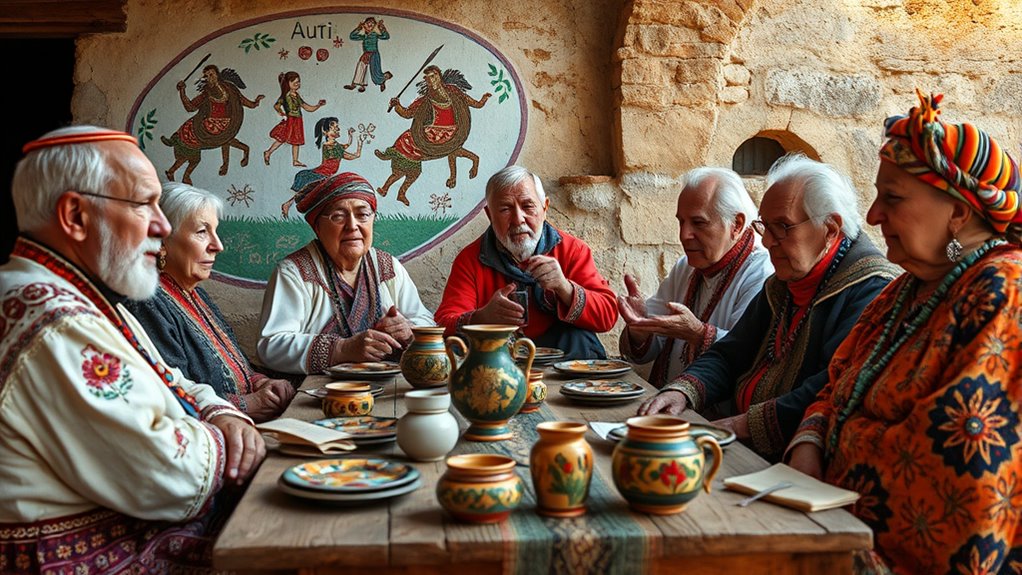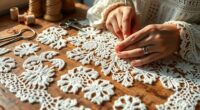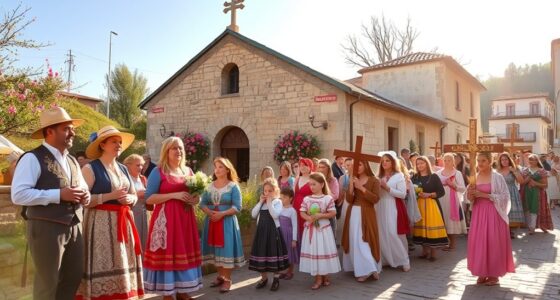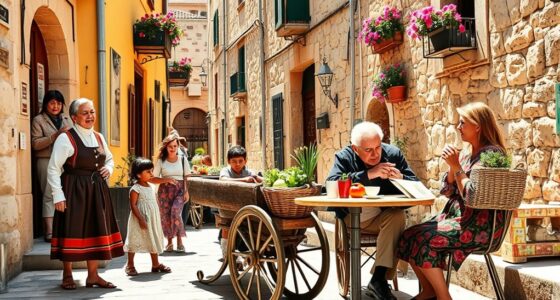Folklore associations in Ittiri play a key role in preserving and showcasing the town’s rich traditions through festivals, costumes, music, and dance. They foster community pride and connect generations by organizing events like the Ittiri Folk Festa, which highlight Sardinian culture. These groups also promote cultural exchange and support local artisans, boosting tourism and the economy. If you want to understand how they maintain Ittiri’s heritage, keep exploring further.
Key Takeaways
- They preserve and transmit Ittiri’s traditions, costumes, dances, and oral narratives across generations.
- They organize festivals and events like the Ittiri Folk Festa to showcase Sardinian cultural heritage.
- They foster community bonds and facilitate intergenerational transmission of customs and folklore.
- They promote cultural exchange through international collaborations, enhancing Sardinian traditions’ global visibility.
- They contribute to cultural tourism and local economic development by attracting visitors and supporting artisan crafts.
Historical Development of Folklore Groups in Ittiri

The folklore groups in Ittiri began as dedicated custodians of the town’s ancient traditions and cultural heritage. You’d see them forming to preserve traditional dances, music, and costumes that reflect the town’s history. Many groups started during local religious festivals and celebrations tied to churches and sanctuaries, serving as a way to pass down cultural knowledge across generations. Their early activities included traditional horse races, processions, and theatrical events, all deeply rooted in Ittiri’s identity. The town’s archaeological sites, like Nuraghe Majore, inspired interest in ancient customs, influencing costume design with traditional materials and motifs. Over time, these groups formalized into associations, organizing events like the Ittiri Folk Festa, which helped sustain and evolve their cultural role. Additionally, the preservation of traditional costume design by these groups plays a vital role in maintaining the authenticity of Ittiri’s cultural expressions.
Cultural and Social Contributions of Local Folklore Societies

You can see how local folklore societies keep traditions alive through festivals, costumes, and performances that connect generations. These groups also strengthen community bonds by encouraging participation and shared pride in Ittiri’s cultural identity. Additionally, they promote cultural exchange by welcoming visitors and showcasing Sardinian heritage on a broader stage. The preservation of ancient customs plays a vital role in maintaining the unique character of Ittiri’s cultural landscape. Moreover, their efforts in organizing traditional events help ensure that these customs are passed down and appreciated by future generations.
Preserving Traditions and Customs
Local folklore societies in Ittiri play an essential role in preserving and promoting the community’s rich cultural heritage. They have dedicated decades to recovering and showcasing traditional Sardinian clothing, with the Ittiri Canneddu association leading this effort for over 50 years. The female costume, once common until the 1970s, remains a symbol of local identity, with older women still wearing updated versions during festivals and religious celebrations. These clothing traditions are crucial during community events, connecting residents to their history. The groups also revive traditional dances, preparing local youth for international festivals and maintaining cultural continuity. Through organizing festivals like the Ittiri Folk Festa, these societies ensure that customs, music, and storytelling stay alive, fostering pride and a deep sense of community. Additionally, the preservation of these customs contributes to cultural and social contributions that strengthen community bonds and promote local identity.
Fostering Community Identity
Folklore associations in Ittiri actively strengthen the community’s identity by celebrating and preserving cultural expressions rooted in the region’s history and landscape. They keep alive dialects, traditional costumes, and oral narratives that define the community’s character. Through events like the Ittiri Folk Festa, residents express shared values, fostering pride and a sense of belonging. These associations also emphasize regional symbols and customs, making Ittiri stand out from other Sardinian towns. They serve as platforms for collective identity, connecting generations and reinforcing local uniqueness. By maintaining traditions and organizing cultural gatherings, these societies ensure that the community remains rooted in its heritage while embracing its distinctiveness. Moreover, these associations often collaborate with local artisans and musicians, promoting traditional crafts and music, which further enriches the cultural fabric of Ittiri. Additionally, their efforts in cultural preservation help sustain the intangible heritage that defines Ittiri’s charm and appeal.
Promoting Cultural Exchange
Celebrating and preserving traditions in Ittiri extends beyond the community’s boundaries through vibrant cultural exchanges at events like the Ittiri Folk Festival. You get to experience diverse folk dance, music, crafts, and cuisine from around the world, fostering mutual understanding. Local folklore associations, such as Ittiri Cannedu, coordinate these efforts by inviting international groups and showcasing authentic traditions. This creates opportunities for meaningful interaction, like workshops and performances, where you can learn directly from global artists. Here’s a snapshot of the festival’s international reach:
| Group Type | Number of Groups | Origin |
|---|---|---|
| National | 7 | Italy and beyond |
| International | 3 | Various countries |
| Intercontinental | 3 | Across continents |
This exchange broadens your perspective and deepens cultural appreciation.
Organizing and Managing the Ittiri Folk Festival
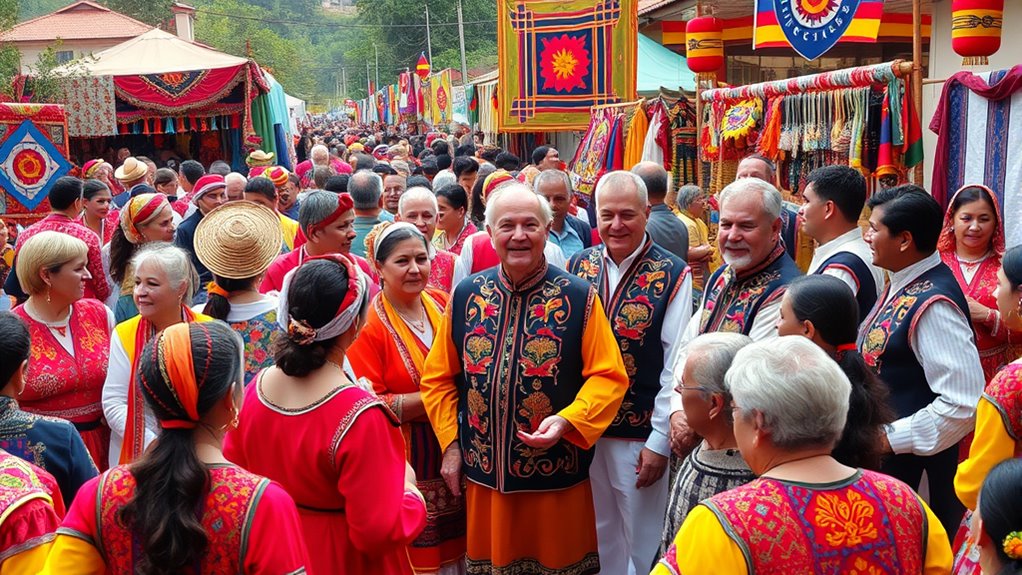
Organizing and managing the Ittiri Folk Festival requires meticulous planning and coordination among various groups and stakeholders. The Ittiri Cannedu Association, active for over 50 years, leads the festival’s organization, working closely with local cultural groups like Ischiglias Association and Coros theater company for historical reenactments. You’ll find venues like Public Gardens and Piazza Marconi to host diverse events, with local authorities ensuring smooth logistics and permits. Additionally, careful attention to event scheduling helps ensure a seamless experience for participants and attendees. Key aspects include:
- Collaborating with international, national, and Sardinian folk groups to create a rich program.
- Coordinating participant logistics, including accommodations and rehearsals.
- Promoting the festival through media, visual arts, and community engagement to boost visibility and attendance.
This teamwork ensures a vibrant, well-organized celebration of Sardinian culture.
Preserving Sardinian Traditions and Material Heritage

Preserving Sardinian traditions and material heritage is a vital effort carried out by local associations dedicated to safeguarding the island’s rich cultural identity. They document and revive traditional crafts like textiles, ceramics, and basketry, ensuring artisans pass down their skills through workshops and demonstrations. Materials, patterns, and tools are systematically cataloged to maintain cultural continuity. Exhibitions showcase authentic Sardinian craftsmanship, boosting public appreciation and demand. Additionally, associations help restore historic sites, from 13th-century abbeys to churches, involving volunteers in preservation efforts. They also promote Sardinian music and dance through workshops and festivals, archiving recordings and choreographies for future generations. Finally, they safeguard the Sardinian language via storytelling, poetry, and youth programs, ensuring these traditions remain vibrant and relevant. Emphasizing cultural preservation strategies, they foster community pride and ensure the transmission of intangible heritage.
Strengthening Community Identity and Regional Pride
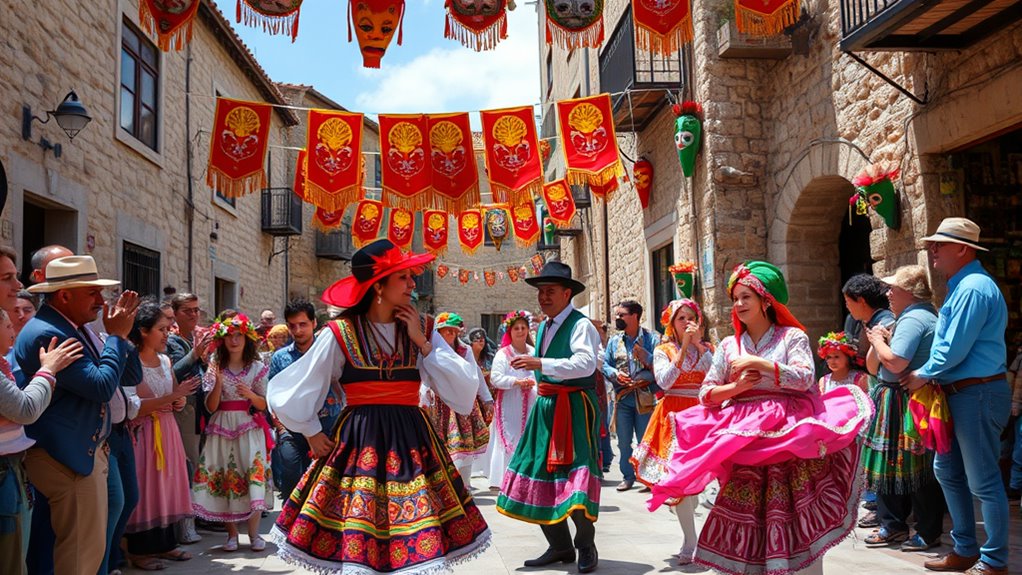
Community events like the Ittiri Folk Festival play a essential role in strengthening local identity and fostering regional pride. These gatherings unite residents and showcase Ittiri’s unique cultural heritage, from traditional costumes to historic performances. By highlighting Nuragic and medieval roots, folklore associations visually affirm the town’s distinct identity to both locals and visitors. The use of local dialects and oral traditions deepens emotional connections, reinforcing a shared sense of belonging. The festival’s international recognition boosts pride and highlights Ittiri’s cultural significance. The preservation of archaeological sites and ancient traditions further enriches the community’s connection to its history, ensuring that cultural heritage remains a vital part of local identity. Celebrating regional history through costumes, music, and dance helps to foster a sense of continuity among generations.
Engaging With Broader Cultural Networks and Initiatives
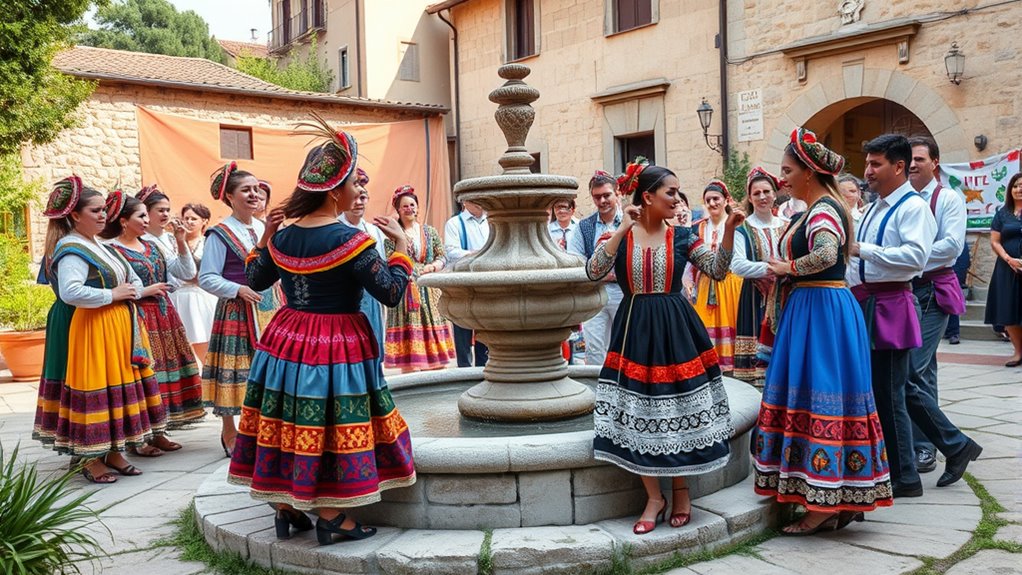
You can expand Ittiri’s cultural reach by participating in collaborative exchanges and international festivals. These efforts connect you with diverse communities and showcase local traditions on a global stage. Engaging in such initiatives helps strengthen cultural ties and broadens the festival’s impact. Additionally, embracing cultural practice through consistent participation fosters resilience and innovation within local traditions.
Collaborative Cultural Exchanges
Folklore associations in Ittiri actively engage with broader cultural networks by building strong connections with regional groups across Sardinia. These collaborations promote the island’s diverse cultural heritage and foster mutual learning. You’ll find initiatives like joint workshops with nearby towns, which highlight unique local traditions and crafts. Sharing expertise in costumes, music, and dance strengthens regional ties and nurtures emerging folk artists. To maintain ongoing cooperation, associations use social media and local newsletters, ensuring continuous communication. Social media platforms serve as essential tools for organizing and promoting joint projects and events. Additionally, establishing inter-regional partnerships allows for the exchange of best practices and resources, further enriching the cultural landscape of Sardinia.
International Festival Participation
The Ittiri Folk Festival has become a vital platform for engaging with broader cultural networks by inviting international folk groups and showcasing Sardinian traditions on global stages. You’ll see diverse performances from groups like Chile, Austria, Mexico, Italy, and Sardinia, spanning dance, music, crafts, and cuisine. The festival, held from July 17–23, 2025, extends across Alghero, Sassari, and Ittiri, creating a vibrant cultural exchange. Local associations, such as Ittiri Cannedu, organize these international collaborations, fostering dialogue and promoting Sardinian heritage. They act as cultural ambassadors, connecting Sardinia to global folk networks and strengthening long-term partnerships. Event organization plays a crucial role in coordinating these international exchanges, ensuring meaningful participation and cultural preservation.
Promoting Intergenerational Transmission of Cultural Knowledge

Community engagement through folklore associations plays a vital role in passing cultural knowledge across generations. These groups create structured environments where elders and youth interact through storytelling, rituals, and crafts, ensuring traditions are preserved. Regular gatherings and festivals offer repeated chances to learn songs, dances, and oral histories, strengthening cultural bonds. Mentorship models pair experienced elders with younger members, fostering skill transfer and continuity. By focusing on local content, these associations limit external media influence, maintaining authenticity. They also utilize oral traditions like folk songs and stories to encode morals and social norms, reinforcing community identity. Additionally, educational programs and apprenticeships provide hands-on learning, while documentation efforts support language preservation. This approach keeps cultural knowledge alive and relevant for future generations.
Folklore associations nurture cultural continuity through storytelling, rituals, mentorship, and community gatherings.
- Mentorship models foster skill transfer
- Community gatherings create learning opportunities
- Documentation supports language preservation
Impact on Local Tourism and Economic Development
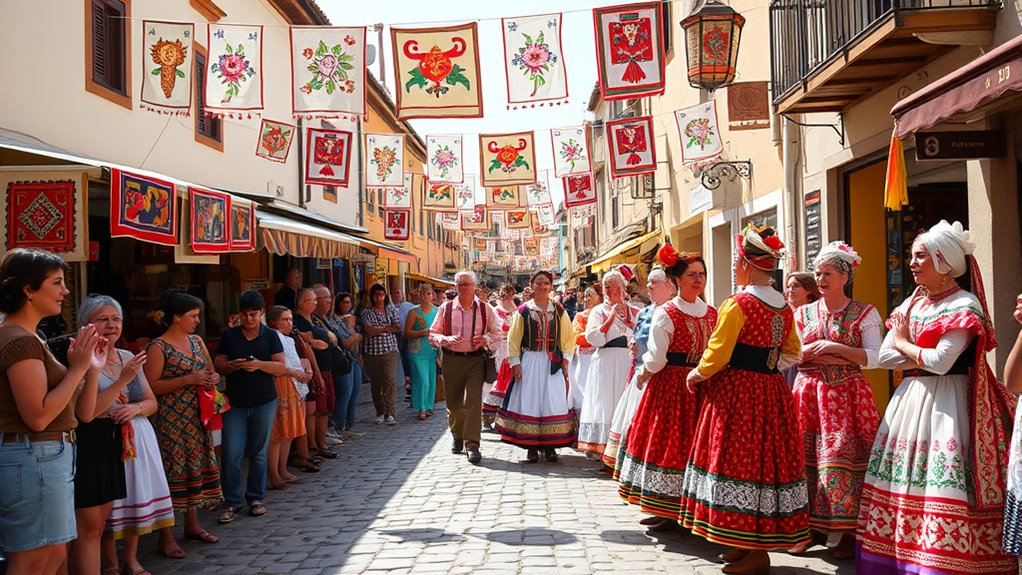
By organizing traditional festivals and cultural events, folklore associations considerably boost Ittiri’s appeal as a tourist destination. These activities, centered on local music, dance, and crafts, draw visitors and enhance cultural tourism. They also help attract tourists during the off-season, stabilizing the local economy. Collaborations with regional tourism boards expand outreach and increase visitor numbers. Folklore-based experiential tours provide unique, authentic cultural experiences that tourists seek. Additionally, folklore groups support local artisans by showcasing handmade crafts, generating income from folklore-inspired souvenirs. Workshops promote skills and employment, while integrating folklore motifs into products boosts their marketability. Overall, these efforts strengthen Ittiri’s cultural branding, foster community pride, and create sustainable economic growth through tourism. Heritage assets play a crucial role in attracting culturally-minded visitors and supporting local identity.
Frequently Asked Questions
How Do Folklore Associations Recruit and Train New Members in Ittiri?
You can recruit and train new members by partnering with local schools and community events to showcase folklore traditions. Host information sessions and open houses to introduce your group’s mission. Use social media and flyers to attract interest, then provide hands-on workshops and mentorship programs to help new members learn skills like dance or music. Keep members engaged with regular activities, recognitions, and opportunities for leadership to guarantee long-term involvement.
What Specific Traditional Sardinian Dances Are Preserved by the Associations?
Imagine stepping into a living museum—here, traditional Sardinian dances are preserved with vibrant authenticity. You’ll find dances like the circular “ballu tundu,” emblematic of community bonding, and “Su ballu sardu,” showcasing northern Sardinian heritage. Religious procession dances during festivals and reenactment dances dramatizing local stories also come alive. These dances, wrapped in costumes and music, keep Sardinian culture pulsating through generations, thanks to dedicated associations.
How Are Modern Influences Integrated Into Traditional Ittiri Folklore Events?
You see that modern influences are woven into Ittiri folklore events by using digital platforms for broader reach, sharing videos online, and engaging social media audiences. Live performances incorporate multimedia elements like projections and sound enhancements, blending tradition with technology. Musicians fuse contemporary genres with traditional music, while dance and storytelling are adapted to reflect modern themes. These innovations keep the folklore vibrant, relevant, and accessible to diverse, younger audiences worldwide.
What Are the Challenges Faced by Folklore Associations in Maintaining Authenticity?
You face challenges in maintaining authenticity because there’s no universal standard, and traditions constantly evolve. Modern influences, commercialization, and technological changes threaten cultural integrity. Internal conflicts, like disagreements over tradition versus innovation, complicate efforts. External pressures from institutions and legal issues also pose obstacles, making it hard to preserve genuine folklore. Balancing tradition with modernity requires steering through these complexities while honoring community perspectives and safeguarding cultural heritage.
How Do Associations Fund Their Cultural Activities and Festivals?
You fund your cultural activities and festivals through a mix of sources. Local community events and festivals boost income via ticket sales and sponsorships, while memberships and donations from community members provide steady support. You also seek grants from government agencies and arts organizations, often with project-specific or multi-year funding. Additionally, you generate revenue by selling crafts, recordings, and merchandise, and secure sponsorships from businesses interested in promoting heritage.
Conclusion
As you walk through Ittiri’s vibrant streets during the festival, you realize how folklore associations have woven tradition into the town’s very fabric. They’re like the ancient olive trees, rooted yet reaching outward, connecting generations and welcoming visitors. In this dance of history and modern life, you see how these groups shape community pride and open doors to new stories. It’s a living tapestry—timeless, yet continually unfolding, just like the sunset over Sardinia’s rolling hills.
